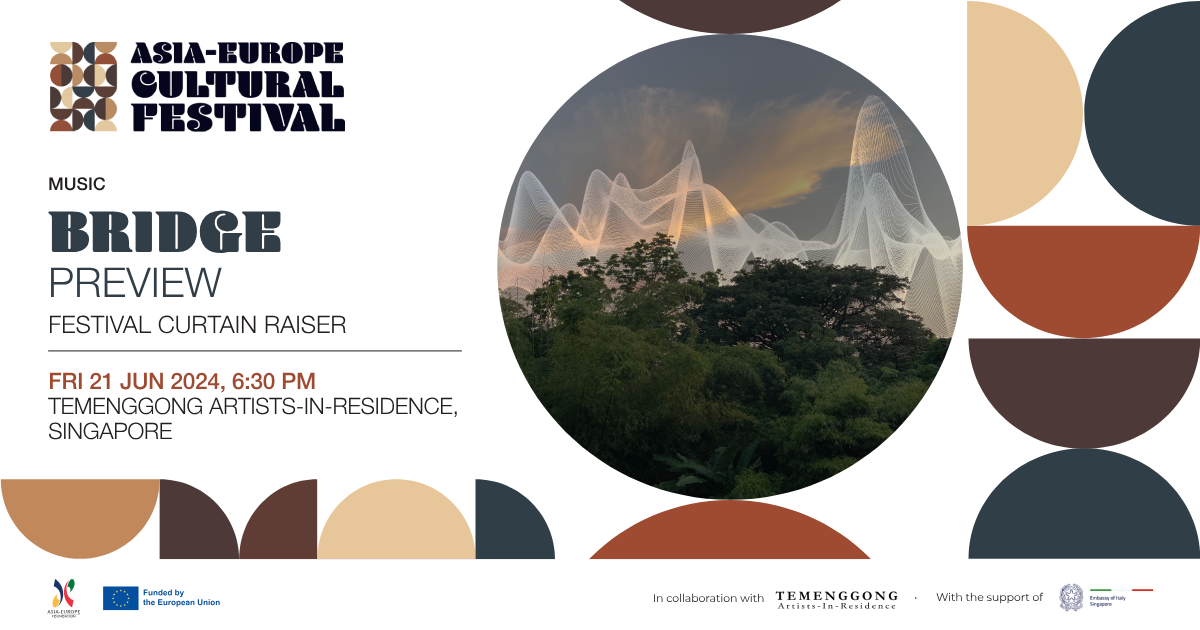MUSIC BRIDGE PREVIEW: FESTIVAL CURTAIN RAISER
The Asia-Europe Cultural Festival is a public arts festival that celebrates the artistic diversity of Asia and Europe and promotes dialogue and exchange amongst artists from the two regions. Presented by the Asia-Europe Foundation (ASEF) since 2078, the Festival offers a diverse range of programmes including performances, exhibitions and roundtables, showcasing the best of traditional and contemporary art forms and practices.
In 2024 the main festival event will be held in Rovereto and Trento {Italy) between 30 August and 7 September. Tonight’s event in Singapore, ASE F’s home base, marks the opening of the festival 2024 with a Curtain Raiser preview of BRIDGE. BRIDGE is a music collaboration of artists from Tempo Reale (Italy) and Siong Leng Musical Association (Singapore). It brings together Nanyin (traditional Chinese folk music) with electronics and sound arts, bridging an endangered intangible heritage with contemporary and experimental elements. The artists have been collaborating since February 2024 thanks to a hybrid residency programme of ASEF – Temenggong Artists-In-Residence.
The full performance will be showcased in Rovereto, Italy in September in the framework of the Asia-Europe Cultural Festival 2024.
This event is by invitation only.
ABOUT THE MUSICIANS-IN-RESIDENCE: Francesco Canavese, Simone Faraci
Founded by Luciano Berio in 1987, Tempo Reale is one of the main Italian points of reference for research purposes, production and education in the field of new musical technologies. Since its beginning, the Center has been engaged in the realization of the Berio’s works, allowing it the possibility of working in the most prestigious musical contexts in the world. The development of a criteria of quality and creativity derived from the Center’s experiences is reflected by its continuous work with both famous composers and artists as well as with young emerging musicians. The main topics of research reflect the multifaceted ideas that have always characterised the choices and initiatives of Tempo Reale: the conception of musical events of great depth, the study of electronic processing of “live” sound, the experience of interaction between sound and space and the synergy between creativity and performance and rigour. In addition to the activity of research in these areas, the Center regularly organises performances, events and projects in collaboration with various institutions in Tuscany involved in the fields of music, theatre and dance, as well as promotes a wide network of educational exchanges.
www.temporeale.it
————————
ABOUT THE SINGAPORE MUSICIANS: Siong Leng Musical Association
Siong Leng was established in 1941 and owes its success to the late chairman, Mr. Teng Mah Seng. Under his guidance, Siong Leng has become an arts company that preserves and promotes Nanyin. Nanyin, which literally means “Music of the South”, is one of the most ancient musical art forms in China and is regarded as a “living fossil”. Serene and elegant, Nanyin music has soothed and uplifted kings and common folk alike through centuries.
Also known as Xianguan or Nanguan, Nanyin has its roots in China’s imperial courts and later flourished in Fujian’s Quanzhou region. Over the years, it spread to Taiwan, Hong Kong, and further to Malaysia, Indonesia, the Philippines, Singapore, and beyond.
The chief musical instruments used in Nanyin ensembles are the pipa (a pear-shaped four-string lute), sanxian (a long-necked three-string instrument, whose sound box is covered with python skin), dong xiao (a vertically-held six-hole bamboo flute) and erxian (a two-string fiddle).
The music is also performed with a full array of percussion instruments. Nanyin is sung in the Minnan dialect and is closely tied with the poetic, rhythmic, and dramatic tunes of Central China. The melodies of Nanyin are all noted in Gong Che Pu, a form of traditional Chinese score notation, and researchers have found more than 2,000 pieces of Nanyin repertoires.
In 2009, Nanyin was inscribed on UNESCO’s Representative List of the Intangible Cultural Heritage of Humanity.
www.siongleng.com


